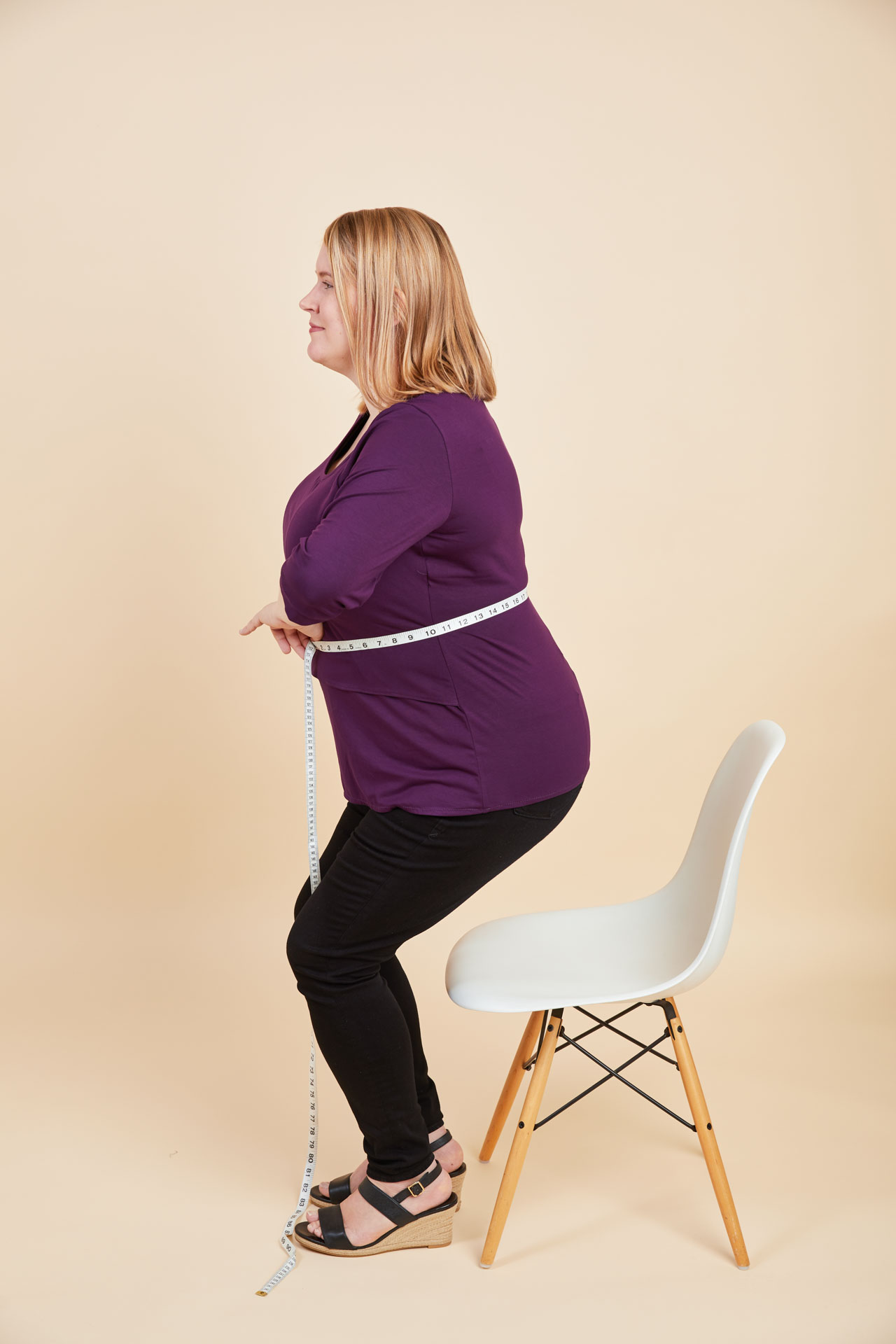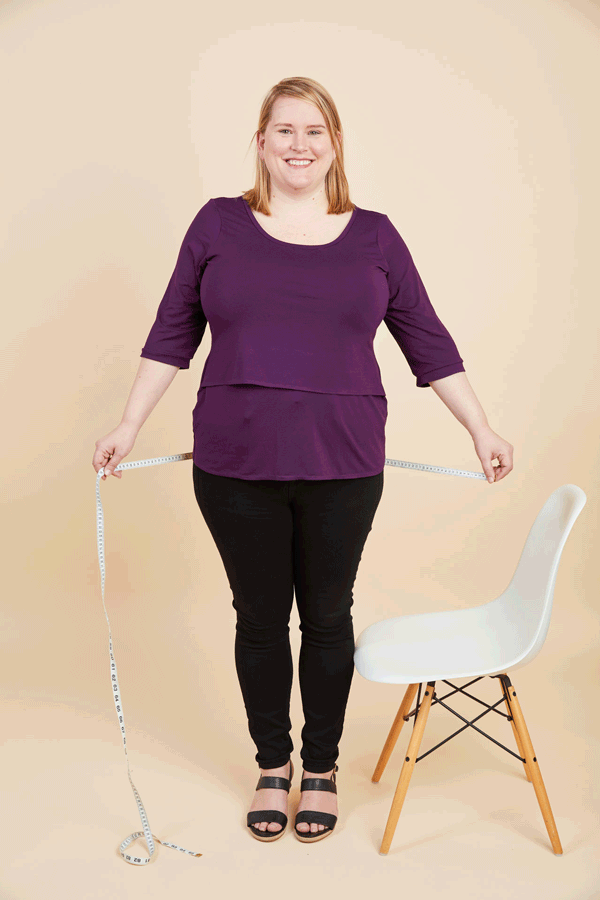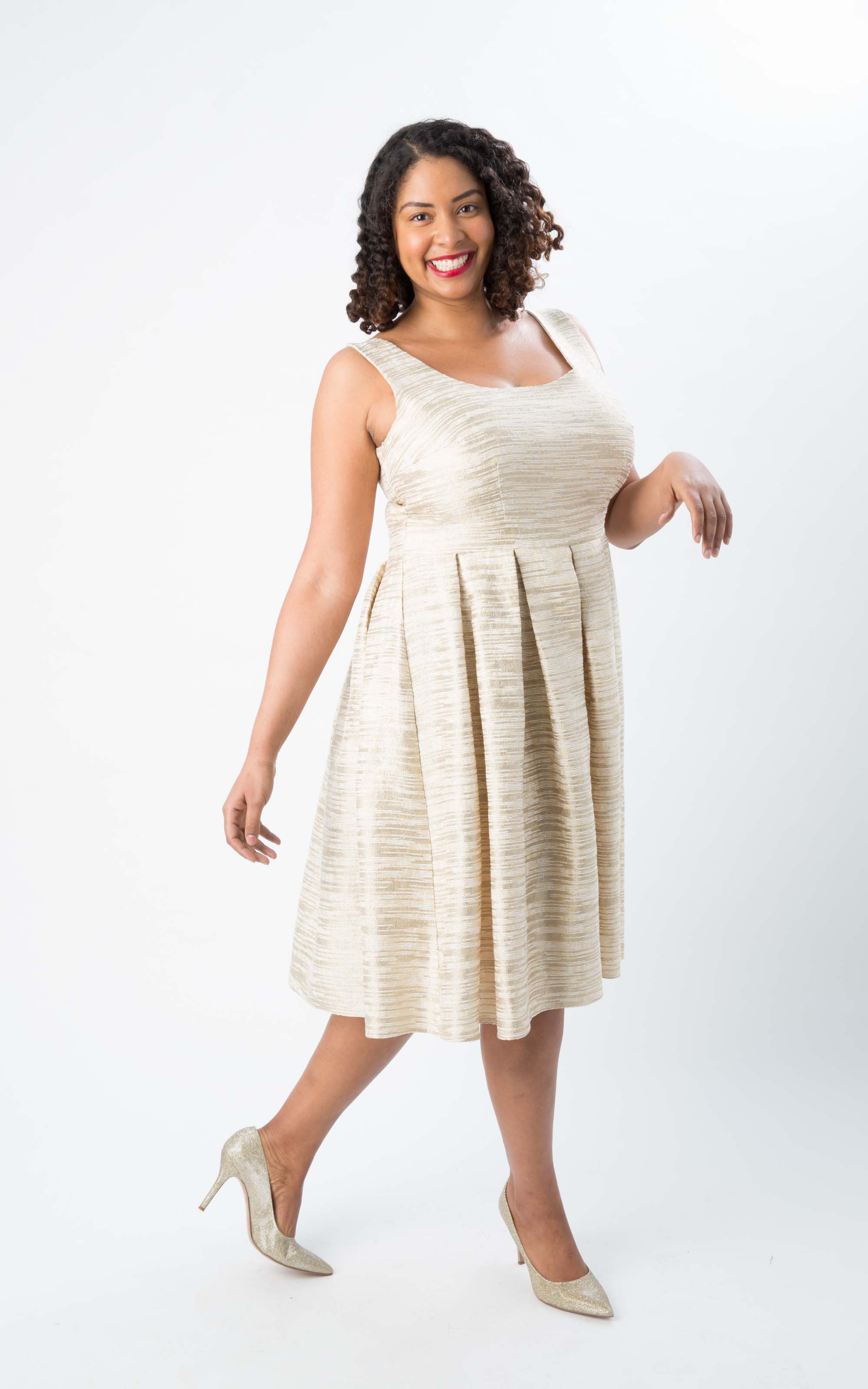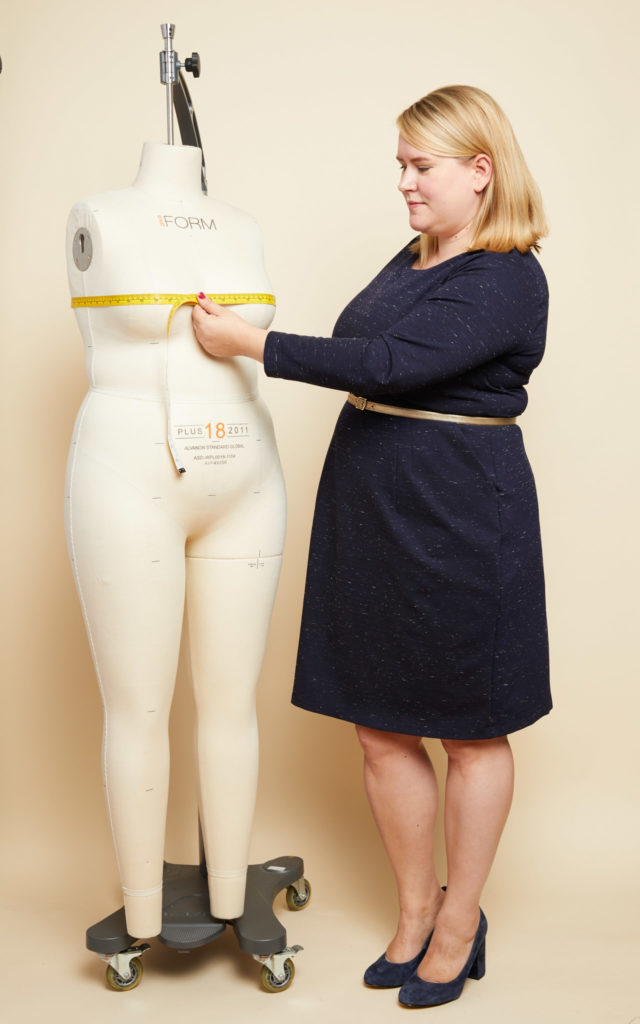The fitting workshops I run are always filled with “aha!” revelations for the participants, but it’s one of the simplest tips I share within the first hour that always seems to have the greatest impact. And that tip? Sit down when you’re taking your waist and hip measurement.

Why should you sit down when taking your waist and hip measurements?
The simple answer is: because almost all curvy and plus size women (and many others!) spread when we sit down.
Depending on your figure and proportions, you may spread more at the waist or hip, but the chances are you’ll spread, and potentially quite a lot – I go up at least 3 – 4″ (for reference, I’m a size 18 – 20).
The reason this is so important is because you want to be able to sit down in your clothes! And, if you want them to fit, well, you’ll need to take your measurements in a sitting position. I don’t know for sure why this technique isn’t more well-known; the only thing I can think of is that because straight size women *tend* to spread less or not at all, it’s not even considered by the majority of fitting books which assume that straight size women are the norm (when in fact we know that plus size is average).
What about your bust and other measurements?
It’s unlikely that your bust changes size when you sit down, although if for any reason it does, then absolutely, sit down first. On your bust, the crucial thing is to wear the bra you’re going to wear with the final garment – at the very least, the same *style* of bra (e.g. t-shirt bra, wired, non-wired etc.). The reason is that the bigger the boobs the more… malleable they are to their container! Which means their projection, size, shape and height can all be radically different depending on your bra or lack of one. If you measure braless then wear an underwire the garment’s not going to fit correctly, for instance.

For other measurements, think about how they’re impacted by sitting. I wouldn’t expect your bicep to change, and probably not your calf, but your thigh measurement may well alter.
How do you actually do it?
Start by standing up and putting the tape around you at your waist or hip. Hold it firmly but not tight, so that the tape can slide between your fingers in a controlled way.

Now, carefully sit down, letting the tape expand but keeping it at the same point around your circumference.

You may need to try a couple of times to keep it in the right place. I actually find this is easier to do by yourself than with a fitting buddy, but you may want to do it in front of a mirror to make sure the tape is staying in the right point. Below, you can see that my hip measurement increased by about 4″.

Is it equally important for all garments and fabrics?
It is absolutely critical for fitted, woven garments – like the Cashmerette Upton Dress (shown below) or a pencil skirt – which have minimal ease. If you make a fitted skirt in a woven to the measurements you take when you’re standing, as soon as you sit down it’s going to pinch and be incredibly tight – unlikely the result you want! Same with the Upton Dress, if you tend to spread at the waist – you may well find it tight at the waistband if you measure standing up rather than sitting down.

In wovens with lots of ease, like the Cashmerette Webster Dress, (shown below), it’s much less important, because there is lots of room within the garment to spread out.

In knits and stretch wovens it’s also less critical, because the garment stretches to fit your body as you move around and sit down. However, depending on how comfortable you are with negative ease, and how stretchy the fabric is, you may still want to consider your sitting measurements to avoid the garment pulling uncomfortably on your body. For instance, if you have a significant spread when you sit, a stretch denim may still feel very tight when sitting, and you’d want to use your sitting measurements.
For this reason, I recommend having TWO sets of body measurements for yourself: one seated, and one standing, so that you can refer to whatever is most relevant for the garment you’re making. It’s also always a good idea to take your measurements before every sewing project – we fluctuate so much, it’s a shame to make something that doesn’t fit just because you didn’t realize your body changed a bit.
I hope this was an eye-opening tip for you! Do you have any questions about this technique?





Mind blowing! I have so many clothes I love to wear as long as I’m standing up, but hate to sit in…did my ‘sitting’ measurements and it added 3 inches to my waist and 3.5 inches to my hips! No wonder!
Loved this topic, what a brilliant idea to measure sitting. That brings up the question of ease… how much to add to the sitting measurements, since ease is designed to accommodate movement and sitting… any thoughts?
It really depends on the type of garment. The challenge is you don’t want something to fall down when you’re standing up, in order for it to fit sitting down. So, I tend to try to get the minimal ease for sitting down – say only 1″. Then when you’re standing, it might be more like 3 – 4 “. You can also look for garments where this isn’t an issue, like stretch wovens, knits, or garments that incorporate some elastic or shirring.
So does that mean you make the pattern at the waist and hip another 4 inches bigger? So you are grading the fabric out another 2-4 sizes?
Once you’re aware of your sitting-down measurements there are a few approaches you can take.
– If you’re ok with being compressed, and it’s the type of garment that doesn’t have the potential to gape open or dig in too badly at one spot in a painful way, then just go ahead as usual! Some people don’t mind.
– Look at the finished garment measurements and see what ease you’ll have once you sit down – for instance say you have a 38″ waist standing but 41″ sitting – if the finished garment measurement is 42″ you might say well that’s going to be fine, I’ll still have 1″ ease when I sit down so I don’t need to change size
– Alternatively, look for designs that move with you – for instance, our latest release, the Holyoke Dress & Skirt, has an elastic waistband at the back, which means as you sit down it will expand with you.
This is why I make my waistbands an inch or two too large and insert a small strip of elastic at the side seams. It doesn’t affect the silhouette much and it gives just enough breathing/sitting/eating room.
I too wonder how the difference in measurements plays out with regard to ease. I’m afraid my pants will be too loose if I choose the size based on my sitting hip measurements.
Once you’re aware of your sitting-down measurements there are a few approaches you can take.
– If you’re ok with being compressed, and it’s the type of garment that doesn’t have the potential to gape open or dig in too badly at one spot in a painful way, then just go ahead as usual! Some people don’t mind.
– Look at the finished garment measurements and see what ease you’ll have once you sit down – for instance say you have a 38″ waist standing but 41″ sitting – if the finished garment measurement is 42″ you might say well that’s going to be fine, I’ll still have 1″ ease when I sit down so I don’t need to change size
– Alternatively, look for designs that move with you – for instance, our latest release, the Holyoke Dress & Skirt, has an elastic waistband at the back, which means as you sit down it will expand with you.
Yay!!! This has been an issue that I’ve never seen addressed before. Several years ago I was visiting with a small sized friend who sews. I told her that because of my fat and big belly my high hip is 9” bigger when I sit down. She didn’t believe me until I got a tape measure and showed her. Knots have been the answer for me….
Brilliant! I always try to sit down or do a few squats when I try on off-the-rack clothing to see if the garment will make it into my work wardrobe. Why haven’t I ever thought to measure sitting down for my bespoke collection?
This is why I can’t really wear woven pants (jeans) anymore. In order for them not to crush my stomach when I sit down, they have to be so big they will barely stay up when I’m standing.
Me too!
insert a panel of elastic on the inside at the two sides or back to keep them snug when you stand
I have to get my jeans to fit around my belly making them too loose at my waist. I have done exactly what Rosie did. Add elastic on both sides so they are more comfortable when standing or walking. I have to check out my measurements when sitting.
Very interesting blog post. I too have never heard of the sit down measurement. But, I have always done a sit down trial in all of my clothes before purchasing or when making my trial garment. I cannot stand for things to be tight or molding to my stomach. Thank you for sharing this important tip.
Wow I was today years old when I found this out LOL It makes total sense and I’m so glad you have figured this out. We are built very much along the same lines so I’m looking forward to reading you posts.
Oh my! I just had this happen to me with the Harrison shirt muslin when I sat down. Now I know why. Thank you for this ah ha moment.
That is so brilliant!!! And so true. Looking for something else and ran into this…so glad I did. THANKS!!!!
Thank you so much – you’ve blown my mind!! I was just about to cut out a pattern for woven trousers and now I’m going to go back and rethink the size so I don’t feel like I can’t breathe when I sit down. Thank you
Oh yes I know this well. There is a 16 inch difference around my hips between the two measurements. The designs I will look for are having box pleated, making jogger pockets (I will use a design print stretch fabric as the background) or have a very loose design. This is why I normally buy my pants instead of making them.
Thank you for this. Even when not at plus size, I spread when I sit. I thought it was my bad posture. Regardless of why, I want to be comfortable.
Very interesting. I am currently going through the frustrated (tearful) stage with a sleeveless woven dress bodice. When I stand the bodice looks fine – when I sit I have wrinkles and too much material ballooning at the front bottom side of the armhole. I’m a 42″, D cup with a narrow chest. I used a high bust measurement with an FBA adjustment. It’s as though I need to down size in the bodice area even more. Do you have any instructions on your blog about this problem? Regards, Sandra
I echo what Adriennes said above. If my pants or skirt are comfortable when I’m seated, it means they are so big that they fall down when I am standing. They don’t exactly fall OFF….just start slipping down, which means I tug them up all day long….or even walk along HOLDING them up. Not a good look. I struggle and struggle with this, trying to find that exact waist measurement and that exact fabric and that exact waist-type that will be comfortable, but not fall down when I am standing. To be honest, it doesn’t exist. Even a yoga waistband, or another option, thin elastic, will eventually cut at the waist after a few cumulative hours of sitting (not even continuous sitting is needed to exhaust my waist’s tolerance of anything cutting it). I have never heard anyone talk about this before!
I’ve been struggling with drafting a pants pattern for a lovely woman with an extra large tummy that hangs below her crotch. I’ve been scouring the internet for tips but all the plus size websites talk about large tummies that are more like me – very plus size but not hanging down that far. So far, I know to make an EXTREMELY long rise in front with a very shallow curve, which pretty much has to be accompanied by a similar shallow curved line in the back because it will pull down when she sits. This shortens her inseam and is requiring a gusset.
Clearly a seated measurement is a must, but I would appreciate any thoughts on how to measure and get the front and back to balance?????
I’m curious if this is how you measure yourself for purchasing pants as well? I recently gained about 30 pounds, so I took my standing measurements and bought jeans that fit accordingly…but when I sit down, they’re quite restrictive. I’m have to sit for several hours a day, and I find that I’m constantly either uncomfortable or unbuttoning and unzipping and letting my tummy pop out. But the measurements for the next size up of pants seemed too big. Do you ever use a measurement between the two to get a feel for the best of both worlds?
I was thinking of trying to make myself a pair of pants that might fit better than what I’ve purchased, but I was going to use the exact same measurements I’d taken standing up and now I’m realizing that I would be pigeonholing myself into the same problem.
My mind is blown.